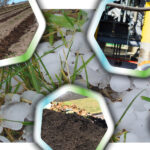BioCycle November 2017
USDA Funds Organics Management Program In Maryland
The Northeast Recycling Council (NERC) has been awarded $65,638 from the U.S. Department of Agriculture’s (USDA) Rural Utility Services Solid Waste Management Grant Program, to implement best management practices and resources for food waste reduction, organics recycling, and manure management in rural Maryland communities. Stakeholders in the Maryland counties of Allegany and Cecil — including citizens, students, business and nonprofit representatives, town staff/transfer station employees and civic leaders — will be engaged in education, training, technical assistance and outreach. NERC’s initiatives include: Project-centered regional training sessions for a wide range of stakeholders; on-site technical assistance to participant communities with the goal of implementing sustainable projects in at least five of the communities; and two project-related national webinars, including Maryland-based case studies and models for success.
The project will further support rural economies by identifying ways to reduce and manage food waste cost-effectively within the community. Exploring opportunities for stimulating local economies, through the use and marketing of compost products, will also be addressed.
NYC Microgrant Program For Food Waste Reduction
The New York City Department of Sanitation’s Foundation for New York’s Strongest launched a Microgrant Program in early November for city businesses seeking to prevent, recycle or recover the more than 650,000 tons of food waste that they throw away annually. Proposals will be accepted from businesses that are working towards food waste prevention, recovery and recycling solutions already, or wish to get started. The Foundation will award grants of up to $2,000, plus technical advisory and other goods and services, to businesses that can demonstrate a need for support and a viable implementation plan.
Businesses may partner together to submit companion applications, which, in total, may receive up to $5,000. Through a technical advisory partnership with New York State, as well as matching funds and donations of supplies, equipment and in kind support, the Foundation will be able to offer grant packages valued at up to $15,000 per grantee.
The Microgrant Program is the first of its kind for the Foundation, exemplifying the organization’s goal to develop and recognize diverse business types demonstrating best management practices to the larger NYC business community. The Mircogrant Program is a result of the successful NYC Food Waste Fair, an educational event held in July 2017 by the Foundation.
Grease In The Green Bins
Cooking oil, shortening, butter, lard or meat drippings washed down the drain bind with other materials and then harden in sewers, which can result in “fatbergs,” clogs and sewage overflows into the environment. Metro Vancouver in British Columbia, and its member municipalities, spend over $2 million annually to unblock sewage pipes and to repair or replace infrastructure impacted by grease. After two successful pilots in Surrey and Richmond, Metro Vancouver is rolling out a region-wide campaign to educate residents about how to properly dispose of their kitchen oils and grease. Its “Wipe It, Green Bin It” message encourages residents to put grease in their green bins, instead of down the sink.
“Simply wipe grease up with a paper towel and place it in your green bin along with food scraps instead of pouring it down the drain,” stated Darrell Mussatto, Chair of Metro Vancouver’s Utilities Committee, in a press release issued ahead of Canada’s Thanksgiving Day in October, when households may have fatty food products such as dressings, oils, meat drippings and butter. “Putting grease down the drain can cause big problems, not only for municipal sewers but also for household plumbing systems. This can lead to backed-up sewers and expensive repairs. It doesn’t matter how much hot water or soap you pour down after the grease. Sooner or later it solidifies.”
Nearly all homes in Metro Vancouver have organics recycling programs that accept small amounts of oil and grease. Large volumes of oil from deep fryers must be collected and taken to specialized recycling depots. To learn more about Grease in the Green Bin — including an explanatory video and words of encouragement from celebrity chef Vikram Vij — visit www.metrovancouver.org/grease.
New California Laws Improve School Food Donations
Despite having enacted one of the nation’s oldest food donor liability protection laws in 1977, California’s official language on the issue was vague and contradictory, The passage in September of Senate Bill (SB) 557 and in October of Assembly Bill (AB) 1219 effectively eliminated any uncertainty for California schools as to when, where and what food they can donate or share after it has first been served in the cafeteria. SB 557 allows public schools to donate specified food that food service staff, pupils, and faculty return to a sharing table at a local educational agency, and that is made available to pupils during the course of a regular school mealtime or then donated to a food bank or any other nonprofit charitable organization, as specified. Food items include unopened cartons of milk and packaged food. SB 557 requires the State Department of Education to update specified guidelines on the donation of leftover food.
Nancy Deming, sustainability manager for custodial and nutrition services at Oakland Unified School District, which has been doing food donation and share tables for many years, consulted with bill sponsor Sen. Ed Hernandez (D-West Covina) to make certain SB 557 fully facilitated food donation. She found that the draft version of the bill did not include items that Alameda County schools were already donating. “SB 557 was directly focused on school food donations, but was not capturing everything we were donating in Alameda County, like hot packaged entrees, fruit with edible peel (apples), and milk,” she told BioCycle.
The final SB557, Deming explained, “reaffirms that school food donation is legal and captures all of the details of what has been approved.” The new law also captures the comprehensive approach to safe food donation and food handling procedures that had been established via StopWaste, Alameda’s waste authority, and the Alameda County Environmental Health Department, she adds. SB557 also calls on the California Department of Education (CDE) to update its information intended to guide schools in how to donate food or create share tables.
In addition, AB1219, the California Good Samaritan Food Donation Act, authored by Assembly Member Susan Talamantes Eggman (D-Stockton), strengthens and expands on the state’s existing liability protections for food donors. The bill requires health inspectors to educate businesses about the laws that exist to protect food donors from liability, which is the first time that a state has mandated widespread outreach for food donation laws. “The requirements of this bill will dispel the myth that food donors can be sued and send a strong signal that good food should never go to waste,” explains Melissa Romero, Policy Associate for Californians Against Waste, a cosponsor of the bill.
Deming explains that AB1219 states that food can now go to the “end recipient,” which cleared up the uncertainty for some schools who would distribute food directly to students’ families: “Our emphasis at Oakland Unified is food for families and then nonprofits. AB1219 allows us to give to students or to student families, as well as to nonprofits. This addresses the importance of giving to those in need, which may not be an official nonprofit, thus legitimizing our program to offer food directly to students and families.” The new law also allows for food donation past its expiration dates, as long as it has been determined to be unspoiled. “Milk would be probably the bigger item that comes up on this issue from time to time,” says Deming, adding that even with the new laws, California schools must still get a stamp of approval from their local health authority.
Biodegradable Plastics Boost Organics Recycling In Italy
A recent study in Italy focused on the effects of biodegradable plastics on plastics recycling streams in Italy, where all single-use carrier bags have to be compostable (according to the European standard EN 13432) since 2011. The findings were jointly released by Corepla, the Italian Consortium for Collecting, Recycling, and Recovering Plastic Packaging; the Italian Composters Consortium (CIC); and Assobioplastiche, the Italian Bioplastic and Biodegradable and Compostable Material Association.
Analyzing the quality of recycled plastics from 19 waste sorting and recycling facilities around the country, Corepla found that compostable plastics only made up 0.85 percent of the plastic input. Similar studies by the University of Wageningen in the Netherlands show that there are no negative effects on the properties of recycled plastics containing starch film and PLA recyclates. Biodegradable plastics are designed to be treated in industrial composting plants. If they do enter mechanical recycling streams due to source separation errors, the German research institute, Knoten Weimar, showed they can be sorted with near-infrared spectroscopy (NIR).
Contamination of organic waste streams with noncompostable plastics constitutes a real problem for composting facilities and negatively affects the quality of compost. CIC, in cooperation with Corepla, conducted tests in 27 composting plants in Italy and found that contamination of organic waste by noncompostable plastics reaches up to 3.1 percent on average.
U.S. Waste Industry Reaches $70 Billion
Waste Business Journal (www.wasteinfo.com) reports that the U.S. waste industry now has revenues of $70 billion. This includes collection, representing 62 percent or $44 billion in revenues; processing, which includes materials recovery and transfer station operations and is 12 percent or $8 billion in revenues; and disposal. Landfilling is a nearly $18 billion segment by itself, and waste-to-energy, a nearly $3 billion enterprise, which together represent 26 percent of the waste business. Total industry revenue rose by 2.5 percent over the previous year and is up 12 percent over the last five years. It is projected to grow by $10 billion over the next five years to nearly $80 billion in 2021, according to the Journal.
Those providing waste management services include publicly traded waste companies, which comprise $40.5 billion or 57 percent of industry revenues. Smaller privately held firms account for $16 billion or 23 percent of industry revenues, while municipalities or governmental players account for $13.8 billion or 20 percent of industry revenues.
The industry as it is comprised today is very different in both composition and size than it was in the early 1990s, when municipal governments performed a much greater share of the service, notes Waste Business Journal. Back then, their participation was close to 35 percent, compared to 20 percent today. Even more dramatic is the ascension of large publicly traded companies that accounted for only a third of the industry in the early 1990s and now account for about 58 percent today. Industry economies-of-scale created a wave of consolidation that began in the mid to late 1990s and continues to this day.










